|
|
|
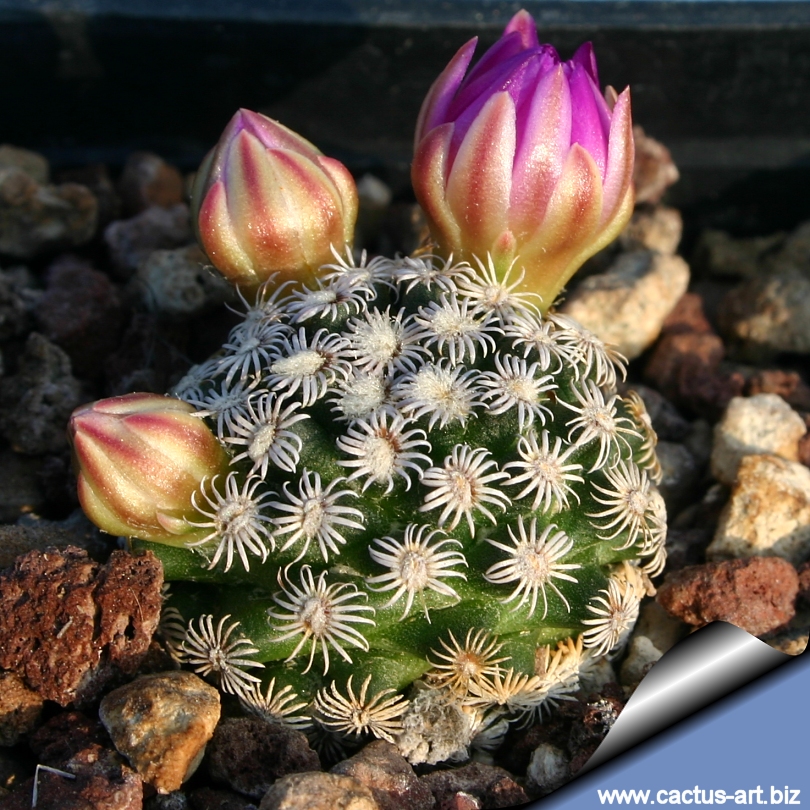
With the uniqueness of the spine patterns this tiny
plant is a real gem
and one of the most
sought-after and distinctive species of Mammillaria.
|
|
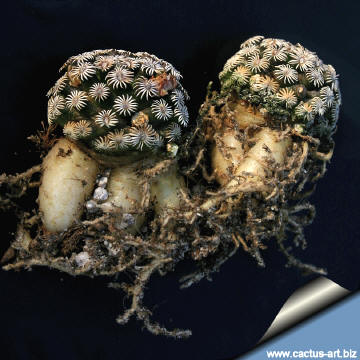 |
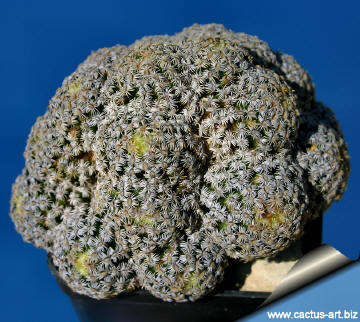
An unusually large specimen (grafted on Trichocereus to speed
growth) |
|
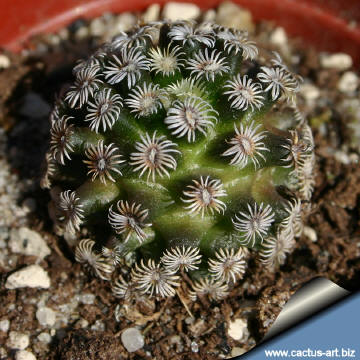 |
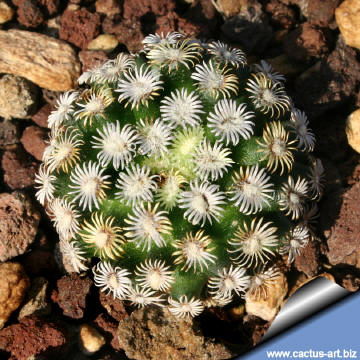 |
|
Cultivation:
Slow growing M. hernadezii is
not the easiest of Mammillarias to grow and keep. The plant is often seen
grafted,
as most of the available stock has so far been propagated this way.
Grafted plants grow fast and are very
floriferous.
But it is not so very difficult to cultivate plants on their own roots given the same care with drainage and
watering that is afforded to other species of Mammillaria with
fleshy roots. It
require a
mineral-based potting mix and
needs to be kept
dry in
winter.
Pot plants are quite
wet-sensitive. Care must be taken with watering,
and they need good
drainage. Water sparingly
during the
growing season, keep very dry in
winter. Usually it is recommended to
over-winter
this plant in a bright and warm greenhouse with at least 8-10° C ,
but it has proved to tolerate temperatures as low
as -5° C for short periods.
The "hernandezii" needs
full sun!!!
Poorer
luminosity levels
produce a green anaesthetic plant with open, far and wide spaced
areoles.
Propagation: Seeds,
cuttings or
grafting. Not too difficult to raise from seed,
but
germination of the seed can still prove to be a challenge. Seeds can be
sown in the spring or summer. The seedlings should not be disturbed
until they are well rooted, after which they can be planted
separately in small pots.
Cuttings
(if available)
root well but plants on their own roots are quite slow.
|
|


Advertising
|
|
|
|
|
Family:
Cactaceae (Cactus
Family)
Scientific Name:
Mammillaria hernandezii Glass & Foster
Pubblished in: Cact. Succ. J. (US) 55(1): 22
(1983)
Conservation status: Listed in
CITES appendix 2.
Synonyms:
Bartschella hernandezii Doweld 2000
Distribution: Central Mexico, Oaxaca,
Tehuacan-Cuicatlan Valley, Altitude 2.300 m.
|
|
Description: Tiny
globular succulent plants, usually solitary (Slowly clumping in
cultivation)
Stems: Depressed-globose to globose, soft, dark green,
usually not more than 2,5 cm in diameter and height (but in
cultivation it can slowly grow up to 4,5 cm in diameter). Without
latex.
Roots: Somewhat fleshy, thickened root
Tubercles: Pyramidal with short white wool in the axil.
Radial spine: 17 - 25, white, cream coloured or tan,
radiating, somewhat pectinate and curved backwards, not interlacing,
1.2 - 2.2 mm long.
Central spine: Absent.
Flower: Cherry red to fuschia-red (or occasionally white)
with a paler throat, relatively large in relation to the stems size,
up to 20 mm long, 2,5 cm large. The flowers are diurnal and close at
night.
Blooming season (Europe): A characteristic of this species is that, at
least when cultivated northern Europe and US, the flowers appears
during Autumn and Winter, and often fails to develop properly due to
cold, damp, and lack of light in a temperate climate. A sufficiently
sunny October day is needed to prompt them to open.
Fruit: Remains embedded in the stem.
Seed: Large, black.
|
|
|
|
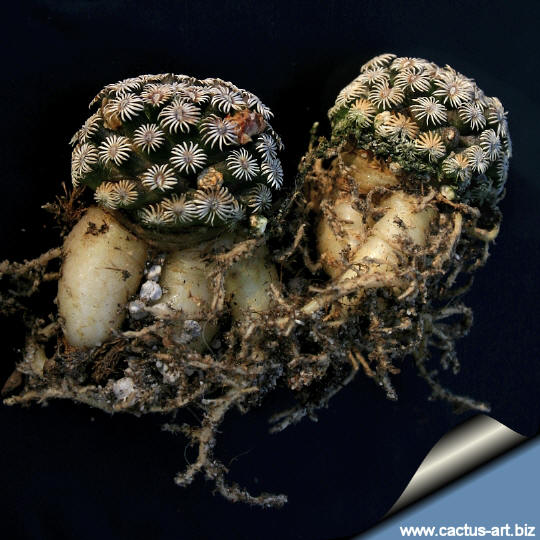
This attractive plant from Oaxaca is still not common in
cultivation.
Surprising large pink flowers (2,5cm) completely dwarf its tiny
body.
This little species is
immediately recognisable by its
spination even when not in flower.
Seasonal
growth and
contraction:
In the
wild this plants
contract considerably during the
dry season, sometimes pulling down completely under the
soil level. Frequently the flowers push up through the dirt
from the
underground cactus
body. In fact, even though this plant shows new
growth each
year, it hardly gets any larger,
and its dimensions remain unvaried
year after year, as the individual
stems tend to
contract at the
base. The new
growth produced during the
vegetative season compacts considerably and
retracts, sometimes pulling down the plant
completely under the
soil in the hottest months of
summer and coldest months of
winter.
It should be noted that "when
specimens are in this withdrawn state, it becomes almost
impossible to find them in their
natural state even though their exact
locality is known"
See also:
Dehydration/rehydration cycles
Cryptocarpic fruit:
M. hernandezii is one of the few
species of cactus with
cryptocarpic fruits. That is, the fruit and seeds are produced
and retained inside the
stem of the plant.
After the
flower
is finished and dropped off, the
stem
closes over the fruit and the fruit/seed
gradually
ripens
within. The following
years
the fruit may remain within the body at the
axil,
or may protrude a bit. A
thin
membrane will be above the part where
ripe seed can emerge. As the plant
swells with the new
growing season, the
membrane fractures, and some seeds
from the past years can little
by little drop down and
germinate in the close proximity, forming small
colonies.
But usually the seeds remain within the plant
body for several
years
(usually about 9) or for the whole
life cycle,
and
frequently
they
will be
released only at the
death
of the plant, after the disintegration of the old stem.
It is possible to
collect
fruit and seeds only by means of a thin pointed
forceps.
The seeds'
vitality
lasts for many years, and moreover
seeds contain
inhibitors
that preserve them from
premature
germination.
Generally
fresh
seeds won’t germinate very well; only old seeds do.
The complete
germination
of this kind of seed may take several years (Some will sprout
unexpectedly after 5 or 8 years!)
Because of the above
peculiarity, seeds and plants of cryptocarpic Mammillaria (Series
Longiflorae) are seldom available from commercial sources.
Viability, measured as the proportion of germinating seeds, varies
widely and is not correlated with seed’s age (e.g. 77% in 8-year
old M. hernandezii seeds). Germination speed, however, increases
with age. That is, given the opportunity (humidity) to germinate,
older seeds do it faster. Slow release of fruits in these species
introduces a time-lag mechanism that has important consequences on
long-term population dynamics. It reduces both population growth and
its temporal variability. This may account both for the rarity of
these species, and for their long-term population stability. This
makes them highly vulnerable to habitat disturbance and has
implications for the strategies required for their conservation. |
|